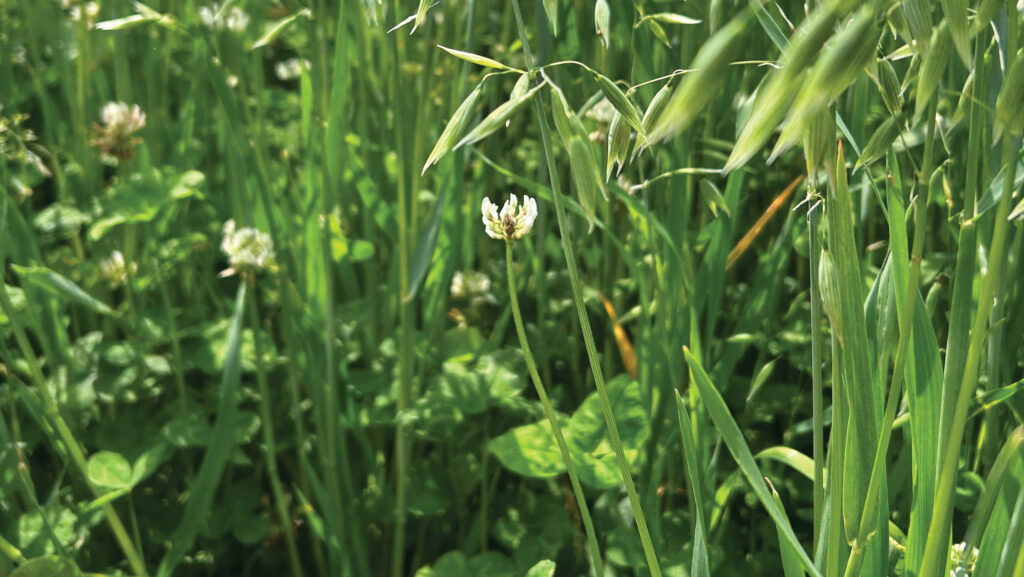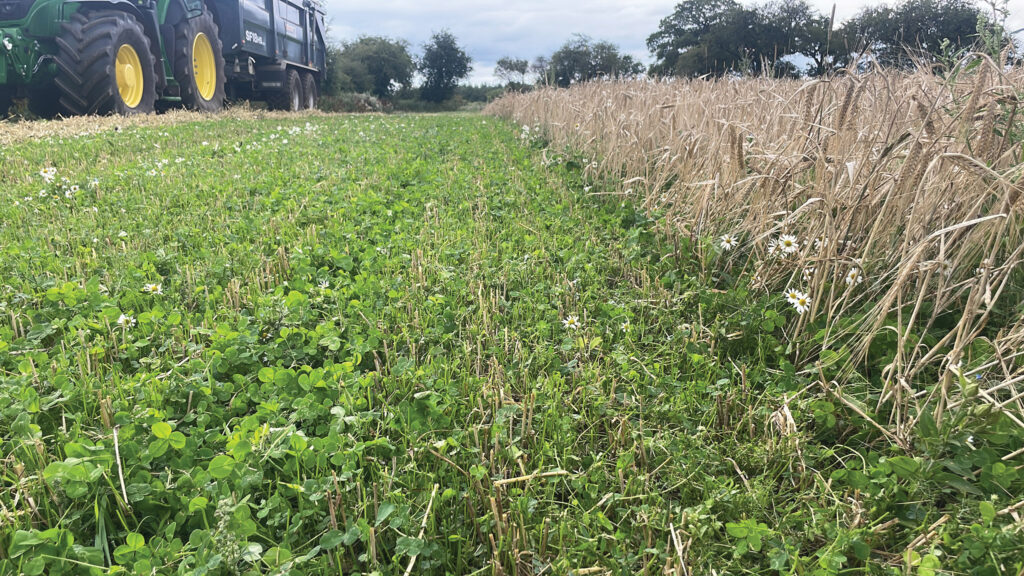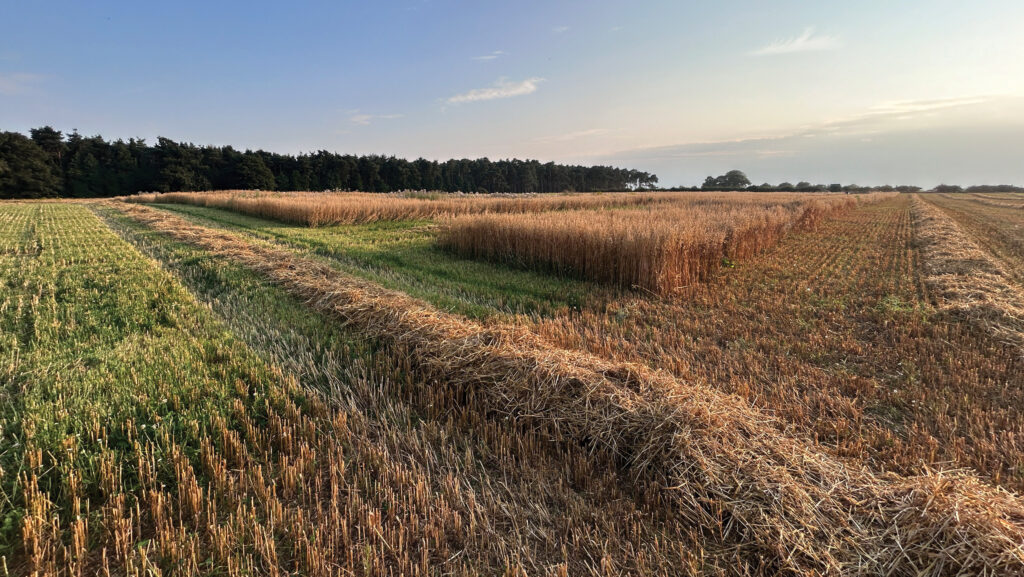Grower reveals insights from four-year clover living mulch trial
 © Matt England
© Matt England Matt England, estate manager at the Fring Estate in Norfolk, has been exploring the potential of clover living mulches, testing how ground-hugging clovers can accumulate nitrogen and suppress weeds.
The idea was simple in concept: eliminate the need for a fertility building ley in the organic rotation by using living mulches.
This would act as a semi-permanent ground cover to fix nitrogen, protect the soil, feed biology and reduce cultivations, all while harvesting a commercial cash crop.
However, Matt soon realised that variety choice, seed rate and establishment all had major roles in the success of clover understoreys.
See also: Is undersowing cereal crops with clover the next big thing?
Farming on sandy, low-fertility soils in north Norfolk is certainly a challenge, and Matt saw good potential in establishing a living mulch.
He is now in year four of the trial, with 1,450ha under management, including 850ha of organic land on the Sandringham Estate.
“I wanted to harvest the sun’s energy in July to September when the solar radiation is at its highest and typically most farms – including ours – have nothing growing in the ground,” he says.

© Matt England
2022: Learning the hard way
The first living mulch trial at the estate kicked off with red clover in March 2022. The team attempted to establish spring barley in an existing red clover sward.
After an autumn silage cut, spring barley was drilled using three different methods: ploughing and drilling, min-tilling, and direct drilling.
Matt used a Weaving Sabre tine drill and the results were mixed at best. A disc drill would have been more effective, he says.
Only the ploughed and drilled plots yielded a successful crop of spring barley. The min-till and direct-drilled plots failed outright, as the aggressive red clover outcompeted the slow-to-start spring barley.
“Drilling in March didn’t allow the barley enough time to establish before the aggressive red clover took over,” Matt explains.
“Red clover was the wrong variety, as spring cereals do not have time to establish alongside a well-rooted clover crop. It will always have more vigour once it comes out of dormancy. Winter cereals are the answer.”
2023: White clover and winter cereals
Matt took another shot in 2023. This time, he switched to Jura small-leaved white clover – the only organically certified four-leaf variety and much less aggressive than the red clover.
This was undersown into spring barley in April using a set of Opico harrows with a seeder box, at 5kg/ha.
By harvest in August, a dense green carpet of clover had emerged. This looked promising throughout the growing season, but proved problematic when it came to harvest.
“The mulch made harvesting more difficult as the bottom of the crop stayed damp for much longer. It was a wet harvest anyway, and too much clover growth got in the way, with green growth in the straw swath,” Matt explains.
In October, the estate team introduced sheep to graze the clover, to manage the mulch ahead of drilling winter oats. Although this was effective, the logistics were complicated.
“We were dependent on the grazier’s availability, which isn’t necessarily the optimum timing for managing the clover mulch,” Matt notes.
The following year the mulch was topped with a mower, providing more control over timing and enabling Matt to drill a crop as soon as the clover hit dormancy.
Come November, Mascani winter oats were drilled using the Pronto drill at a higher-than-usual rate of 400 seeds/sq m.
This was about 20% higher than the farm average, with the aim of giving the oats a competitive edge over the clover.
“Again, this is not a proper direct drill but because we have very light soil, I can direct drill with it as long as I roll afterwards to close the slots,” he says.
“Oats get away very quickly compared with something like wheat, which doesn’t have the same vigour.”
2024: Increasing cereal seed rate
By February, the oats had established well, following a very mild winter, and the clover was still largely dormant. To push the oats further, Matt applied 20cu m/ha of digestate.
As spring arrived, the oats and clover grew well together, successfully outcompeting annual weeds.
“We didn’t see much weed pressure,” Matt says. “As long as you’ve got good crop cover by March, you’re in a strong position.”
Still, thistles and docks remain a challenge, and their growth habits must be carefully considered when determining how long to keep a living mulch in place.
Differences in tillering were apparent in June. In low-fertility areas, oat tiller numbers dropped.
A total of 228 tillers/sq m were recorded compared with 324 tillers/sq m in control plots, suggesting a potential 20% yield penalty.
However, the oats looked healthier overall, with more seeds per panicle in the mulched fields, potentially mitigating some of the loss.
Harvest in August confirmed the prediction: a 21% yield drop compared with control areas, offset by a modest cost saving of £40-£50/ha from not ploughing the field.
Higher yields were witnessed in the ploughed areas as opposed to min-tilled.
“There were also some variations caused by pigs present in the rotation. The best-yielding parts of the mulch trial were where I had accidentally overlapped the drill, so had a lot more seed there.”
This insight sparked a crucial change: seed rate. “After harvest, we topped the clover and drilled winter oats a month earlier, increasing the seed rate to 700 seeds/sq m,” says Matt.
“The goal was to get ahead of the clover from day one.”

© Matt England
2025: New contenders – yellow trefoil and winter rye
By March this year, early signs looked promising. “The oats looked good. They suppressed the mulch more effectively than last year.”
The key, Matt believes, is exploiting the 5C temperature gap between when cereals and clovers begin growing in spring. “It’s all about competition to make the system work,” he says.
“The cereal has to beat the clover out of the blocks.
“The drought this year has caused some challenges, but luckily a late rain kept the trial going so things are looking good again, and, hopefully, we won’t see the significant seed yield drop we were expecting earlier in the spring.”
Matt is now trialling yellow trefoil as a new living mulch.
“It’s all about rooting depth,” he explains. “Yellow trefoil puts roots deeper into the soil at 30-60cm, so it shouldn’t compete as directly with oats [in the early growth stages] for moisture.
“White clover sits in the same root zone [15cm-30cm] as the establishing cereal, which can be problematic on light soils.”
Similarly, hybrid winter rye has proved very effective as a monocrop during the drought this year. Its deep rooting structure and early vigour may be the answer to getting ahead of the mulch in the spring, even during a drought.
His plan is to undersow yellow trefoil in April alongside a white clover trial, and drill winter oats and winter rye into the mulch in the autumn.
Having applied for the Adopt funding grant alongside two other farmers, and with the support of the Organic Research Centre and Cope Seeds, Matt is hoping to take the trials to the next level, investigating a range of different mulch species and cereal combinations.
Finally, the plan is to plough the mulch in spring 2027 to get rid of perennial weeds and sow a spring cereal crop, which he hopes will benefit from the N-fixing build-up from the two years of clover.

